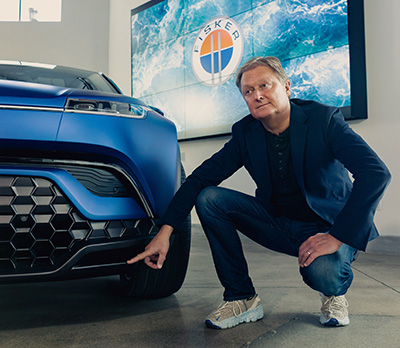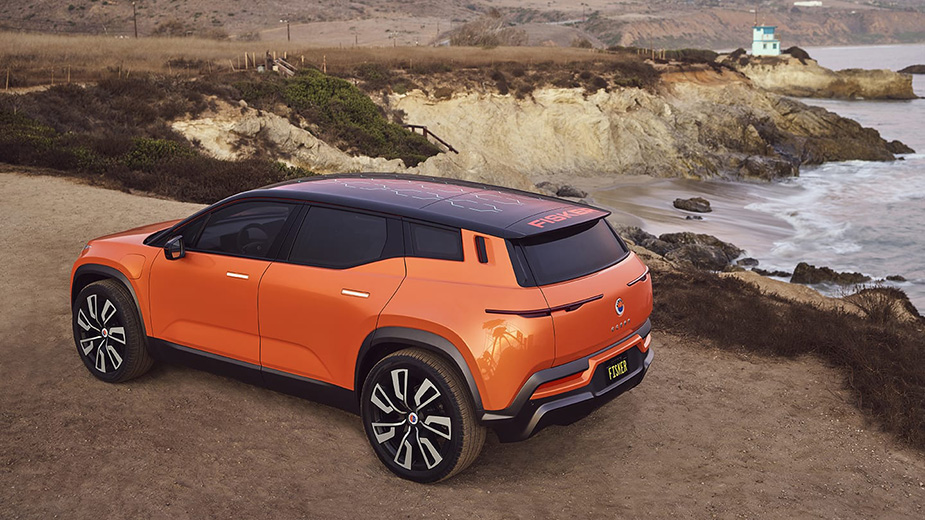LORDSTOWN, Ohio – Henrik Fisker, the billionaire chairman and CEO of Fisker Inc., says his company scouted several sites across the country as a potential location for its new electric-vehicle program, named Project Pear.
“We needed a high-volume automotive plant for this vehicle in the U.S.,” Fisker tells The Business Journal. “The idea is to come up with a high-volume, very affordable and exciting EV that redefines mobility.”
The company and the project’s manufacturing partner, Taiwan-based Hon Hai Technology Group, better known as Foxconn, were in the market for a factory that could accommodate production of 250,000 vehicles or more annually, Fisker says. “Fortunately, there were several plants in the U.S. for sale,” he says.
One stood out. In the end, the partnership settled on the former General Motors Lordstown assembly plant, now owned by Lordstown Motors Corp.
“I was there a few months ago,” Fisker says, speaking from his office in California. “There are some great people there, a talented workforce.” Moreover, the auto executive says that the factory has ample space to satisfy the company’s production needs.
“At this point, the Lordstown plant looks like a really good choice,” he says.
Lordstown Motors announced Oct. 1 that it had reached an agreement in principle to sell the 6.2-million-square-foot plant to Foxconn for $230 million. Under the proposed deal, Foxconn would serve as a contract manufacturer for the Endurance, the EV full-size pickup in the validation phase of production at the plant.
The agreement also opens the door for Fisker to begin work on Project Pear – an acronym for Personal Electric Automotive Revolution – at the Lordstown plant, its CEO says.
Fisker describes Pear as a “pretty high-volume passenger vehicle” that seats five and priced just under $30,000 before incentives. The company is keeping additional details close to the vest, citing the “revolutionary design” of the vehicle that Fisker wishes to keep confidential. Indeed, Fisker doesn’t plan to unveil the vehicle until late 2023, shortly before it plans to move into production.
“We think it will bring a jolt to the industry,” Fisker says. “We think it’s very radical and there’s a good chance it will be successful. We would like the capability to raise volumes.”
What is most appealing about the new EV, Fisker says, is that it defies classification. “We’re not putting this vehicle into a specific segment such as a sedan, SUV or pickup,” he says. “We can attract people from all spectrums and increase the market for this vehicle.”

The 58-year-old Fisker, born in Allerod, Denmark, began his automotive career in 1989 at BMW Technik, an advanced design studio in Munich where his first project was the E1 electric concept vehicle. While at BMW, Fisker took the lead in designing what became the Z8 roadster and worked on the design of the automaker’s first SUV, the X5. He then joined the Ford Motor Co. in 2001 as design director at Aston Martin, where he was in charge of developing the DB9 and V8 Vantage.
In 2007, Fisker founded Fisker Automotive in California, which launched the Fisker Karma in 2011, a luxury electric hybrid vehicle. However, the company’s largest battery supplier filed bankruptcy in 2012, leaving Fisker Automotive without a power source. Fisker filed for bankruptcy in 2013 after producing about 2,000 vehicles.
The assets of Fisker Automotive were purchased in 2014 by Wainxiang, a Chinese automotive parts supplier that formed Karma Automotive. Ironically, Karma filed a lawsuit against Lordstown Motors last year, alleging it poached Karma employees and misappropriated its trade secrets. The case is scheduled for trial next summer.
In 2016, Fisker established Fisker Inc. Two years later, the company announced its plans to build an all-electric SUV, the Ocean, for the mass market. In 2020, the company struck a manufacturing deal with Canada-based Magna International Inc. to produce the new vehicle from its carbon-neutral plant in Graz, Austria. The Fisker Ocean comes equipped with a solar-paneled roof and a battery range of 300 miles and is expected to begin production in late 2022.
“We’ll start deliveries in November of next year,” Fisker says, including to customers in the United States.
More important, the company has the money to launch the Ocean and to begin work on the Pear. In October 2020, Fisker Inc. went public through a special purpose acquisition company, or SPAC. The company has since raised about $1.6 billion, and has “1.4 billion in the bank,” he says. “We have the cash. And we have a very good first product with about 18,000 orders.”
As for Fisker’s second venture, Project Pear is expected to see production sometime during the first quarter of 2024, although that schedule could accelerate should Foxconn’s purchase of Lordstown close.
“With an existing plant such as Lordstown, we could start production a little earlier,” Fisker says.
Prototype manufacturing could begin as early as next year, he says.
Lordstown Motors, which purchased the former GM plant in 2019, is in need of cash so it can launch full production of the Endurance pickup. Under the proposed deal, Foxconn would serve as a contract manufacturer for
the Endurance and future models for Lordstown Motors, while simultaneously producing Fisker Inc.’s mass-market EV.
“It’s a fascinating business model,” says Brett Smith, director of technology at the Center for Automotive Research in Ann Arbor, Mich. “It changes drastically everything we know about vehicle manufacturing and turns it on its head.”
The trend toward contract manufacturing has emerged as a hot topic across the industry, Smith says, and it’s essentially playing out in three ways. First, legacy automakers such as GM have partnered with other major OEMs to build vehicles. Most recently, Honda has agreed to use GM’s Ultium platform. The Detroit automaker has agreed to build Honda’s new all-electric Prologue SUV.
Then, there are traditional contract-builds, such as Magna International, an automotive company that has partnered with other automotive designers and engineers and performs the manufacturing, Smith says.
The latest trend evolving, however, relates to non-traditional automotive companies, such as Foxconn, which are edging their way into the EV space, Smith says.
“These are consumer electronics manufacturers,” he says.
Foxconn, however, does have some experience in manufacturing components for automakers in China. So it’s ahead of the curve in some respects as the EV market matures in North America.
“Foxconn plays to the idea of being a cellphone on wheels,” Smith says. “They’ve got a ton of other capabilities.”
All of this is under the assumption that the proposed Foxconn purchase of Lordstown holds up and much could change over the next several months. “Time will tell,” Smith says.
Meantime, the deal throws Lords-town Motors a vital lifeline. “It gives Lordstown Motors access to what it needs: cash and engineering skills,” Smith says.
Lordstown Motors has weathered a tumultuous year. In October 2020, the company went public via a SPAC and saw its stock price soar to more than $30 a share by February. The stock crashed in March, after a short-seller’s report alleged company officials misled investors in public statements regarding preorders of the Endurance. Year-to-date, shares of Lordstown Motors are down almost 75%.
In June, founder and CEO Steve Burns resigned, as did the chief financial officer of the company, while an amended annual report filed the same month stated that the company might not have enough money to continue through 2022. Meanwhile, the U.S. Securities and Exchange Commission and the U.S. Department of Justice are investigating the company over preorders and its SPAC deal.
Then in August, the company named Daniel Ninivaggi as CEO, who pursued a path first suggested by interim Executive Chairman Angela Strand to leverage the assets of the plant in Lordstown to secure much-needed capital to produce its vehicles.
Foxconn proved a likely suitor. The Taiwanese company, best known for manufacturing iPhones for Apple Inc., has over the last two years ventured into the EV market. In September, the company announced a partnership with Thailand-owned oil and gas giant PTT to construct a plant in that country dedicated to EV production. A year ago, Foxconn displayed a prototype of its own EV platform. There is speculation that the tech company is a strong contender to build EVs for Apple, which is considering a leap into the segment.
“I would think given what we know of Foxconn, it makes total sense for them to look for other brands to make vehicles for,” says the Center for Automotive Research’s Smith. “I don’t think they’re going to be committed to one company alone.”
Fisker says he projects investments of “hundreds of millions” of dollars to retool the factory in Lordstown so it can accommodate manufacturing for Project Pear. Should vehicle production hit its target of 250,000 annually, employment at the plant could be significant. “When you make a high volume that eventually gets to 250,000 a year, you’re looking at thousands of jobs,” he says.
The Mahoning Valley also has a steep and honored manufacturing reputation. The infrastructure is perfect for what the company wants to accomplish, Fisker says.
He’s confident that the partnership with Foxconn adds a tremendous boost to his plans. “We’re putting two companies together that are well-funded,” he says. Foxconn, he notes, is innovative, global and a major player in the technology supply chain.
“With all these parts coming together, it’s a deal that will work,” Fisker says.
Pictured: The Fisker Ocean, manufactured in Austria, is set to launch in late 2022.
